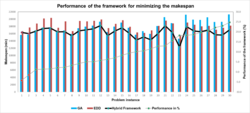A hybrid framework for solving multi-objective scheduling problems

Autor(en):
Abdulrahman Nahhas, Prof. Dr. Klaus Turowski
The proposed new technologies in the context of industry 4.0
challenge the current practices of scheduling in industry and their associated
research in academia. The conventional optimization techniques that are
employed for solving scheduling problems are either computationally expensive
or lack the required quality. In addition, the majority the previous works
addressed either a single objective or a weighted sum objective optimization
measure. Therefore, we propose an adaptive scheduling framework to address
hybrid flow shop scheduling problems considering multi-objective optimality
measures. The framework is motivated by a hybrid design to combine the use of
heuristic and metaheuristic approaches. The main idea behind the presented
concept is to achieve an acceptable tradeoff between the quality of the
suggested solutions for a problem and the required computational effort to
obtain them. We relied on the Non-dominated Sorting Genetic Algorithms III
(NSGA III) to design the control strategy and developed a set of allocation and
sequencing heuristics. The obtained computational results are compared to pure
metaheuristics for solving thirty problem instances that are obtained from a
manufacturing environment in the field of printed circuit board assembly production.
The preliminary computational results show that the framework fully dominates
the metaheuristic for solving 86.6 %
of the problem instances. The framework delivers a set of high-quality
solutions for solving the problem in an average of 4.5 % fraction of the required computational time of the
metaheuristic (2 minutes). Thus, it
can be employed for addressing scheduling matters in manufacturing environments
in real-time. In terms of perused objective measures, the approach delivers in
average up to 21 % better results
for minimizing four objective values than the metaheuristic as shown for
instance in Figure 1.



